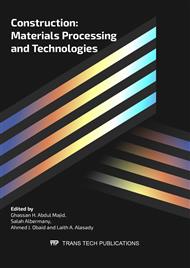[1]
P. Sikora, E. Horszczaruk, K. Cendrowski, and E. Mijowska, The Influence of nano-Fe3O4 on the Microstructure and Mechanical Properties of Cementitious Composites, Nanoscale Research Letters, 11:182 DOI 10.1186/s11671-016-1401-1, (2016).
DOI: 10.1186/s11671-016-1401-1
Google Scholar
[2]
A. Rattan, P. Sachdeva, A. Chaudhary Use of Nanomaterials in Concrete, International Journal of Latest Research in Engineering and Technology (IJLRET), Vol. 2(5), pp.81-84, 2016. http://www.ijlret.com.
Google Scholar
[3]
J. Silvestre, N. Silvestre, and J. de Brito Review on concrete nanotechnology,, European Journal of Environmental and Civil Engineering, Vol. 20(4), pp.1-31, (2015).
DOI: 10.1080/19648189.2015.1042070
Google Scholar
[4]
J. Bogdan, A. Jackowska-Tracz, J. Zarzynska, and J. Plawinska-Czarnak Chances and limitations of nanosized titanium dioxide practical application in view of its physicochemical properties,, Nanoscale Research Letters are provided by courtesy of Springer, 10:57, (2015).
DOI: 10.1186/s11671-015-0753-2
Google Scholar
[5]
P. Sikora, E. Horszczaruk, and T. Rucinska The effect of nanosilica and titanium dioxide on the mechanical and self-cleaning properties of waste-glass cement mortar,. Proc. Eng, Vol. 53, pp.108-146, (2015).
DOI: 10.1016/j.proeng.2015.06.130
Google Scholar
[6]
T.M. Mendees, D. Hotza, and W.L. Repette, Nanoparticles in cement based materials: A review , Rev. Adv. Mater. Sci, Vol. 40, pp.89-96, 2015).
Google Scholar
[7]
N. A. Yazdi, M. R. Arefi, E. Mollaahmadi, and B. A. Nejand, To study the effect of adding Fe2O3 nanoparticles on the morphology properties and microstructure of cement mortar,. Life Science Journal, vol. 8(4), pp.550-554, 2011, (cited by Sikora et al. 2016 [1]).
Google Scholar
[8]
A. Nazari, S. Riahi, F. Shamekhi, and A. Khademno, Benefits of Fe2O3 nanoparticles in concrete mixing matrix,, Journal of American Science, Vol. 6(4), pp.102-106, 2010, (cited by Sikora et al. 2016 [1]).
Google Scholar
[9]
M.A. Sanjuán, C. Argiz, J. C. Gálvez, E. Reyes Combined effect of nano-SiO2 and nano-Fe2O3 on compressive strength, flexural strength, porosity and electrical resistivity in cement mortars,, Materiales de Construcción, Vol. 68 (329), 2018. e150. https://doi.org/10.3989/mc.2018.10716.
DOI: 10.3989/mc.2018.10716
Google Scholar
[10]
ASTM C 150 standard Specification for Portland Cement, American Society for Testing and Materials. CFR Section(s): 30 CFR 250.901(d) (9).
Google Scholar
[11]
IQS, Iraqi Specification, No.45, 1984, Specification of natural aggregate.
Google Scholar
[12]
B.S.1881. Part 116, (1989).Method for determination of compressive strength of concrete cubes,. British Standards Institution, 3 pp.
Google Scholar
[13]
B.S.1881. Part 118, (1989), Method for Determination of Flexural Strength,, British Standards Institution, 3pp.
Google Scholar
[14]
Sen Du, Junliang Wu, Othman AlShareedah, and Xianming Shi Nanotechnology in Cement-Based Materials: A Review of Durability, Modeling, and Advanced Characterization, Nanomaterials , 9(9), 1213; 2019, https://doi.org/10.3390/nano9091213.
DOI: 10.3390/nano9091213
Google Scholar
[15]
H. Li, H.G. Xiao, J. Yuan, J. Ou Microstructure of cement mortar with nano-particles,, Compos: Part B: Eng, Vol. 9, pp.35-185, 2004. (cited by Du et al. 2019 [14]).
DOI: 10.1016/s1359-8368(03)00052-0
Google Scholar
[16]
H. Li, M.H. Zhang, J.P. Ou. Abrasion resistance of concrete containing nano-particles for pavement,. Wear, Vol. 260, p.1262–1266, 2006. (cited by Du et al. 2019 [14]).
DOI: 10.1016/j.wear.2005.08.006
Google Scholar


